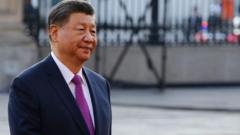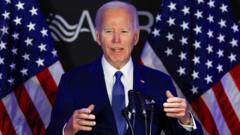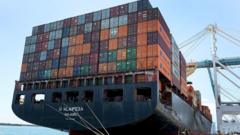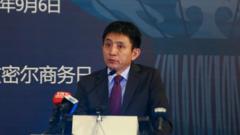With mutual tariff escalations intensifying, experts highlight the looming economic repercussions as China prepares to withstand the storm of sanctions from the U.S.**
China's Stance Toughens Amid Intensifying Trade War with the U.S.**

China's Stance Toughens Amid Intensifying Trade War with the U.S.**
Amid President Trump's tariff threats, China's unwavering position signals a prolonged economic conflict.**
China is fiercely standing its ground in the escalating trade war with the United States, showing no willingness to yield as tariffs proposed by President Donald Trump threaten to nearly double on numerous imported Chinese goods. In a provocative move, Trump has hinted at a staggering 104% tax on items such as smartphones, computers, and various electronic gadgets, raising tensions significantly between the two economic powerhouses.
As the situation develops, observers warn that China is unlikely to rescind its tariffs unilaterally, fearing the perception of weakness and the potential for increased U.S. demands. “It’s a dangerous deadlock that could lead to sustained economic distress for both sides,” noted Alfredo Montufar-Helu, a senior advisor at The Conference Board’s China Center.
The ongoing trade friction has already affected global markets, with Asian stocks experiencing significant volatility. The latest round of U.S. tariffs, which impact numerous other countries as well, had a major hit on Asian economies. As the deadline to implement new tariffs looms, China has responded with retaliatory measures that include taxes of 34% and potential future strategies to further weaken their currency to boost export competitiveness.
Experts speculate about the far-reaching consequences this trade struggle will have, not only on China’s economy—which is already grappling with slowing growth and rising unemployment—but also on the U.S., which has imported substantial goods from China, leading to a trade deficit nearing $295 billion.
The intertwining economic ties between the U.S. and China mean that they cannot merely rely on tariffs as a solution, as Deborah Elms from the Hinrich Foundation explains. “There are varied ways in which both nations could flex their economic muscles, and while it seems negotiations might be on the horizon, the pace and intensity of the current conflict leave much uncertain,” she stated.
The future of this trade war remains opaque, as some analysts suggest private discussions may occur, although skepticism abounds. "The stakes are high and the speed of escalation is alarming," said Roland Rajah, lead economist at the Lowy Institute, underscoring the unpredictable nature of the conflict. In essence, both countries find themselves at a precipice, with no clear resolution in sight.






















